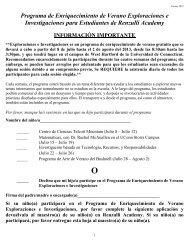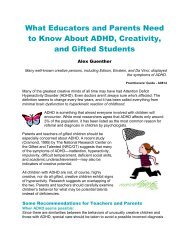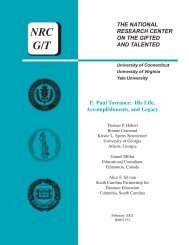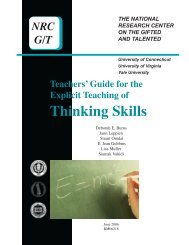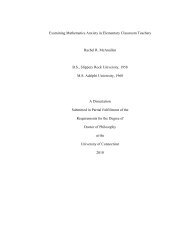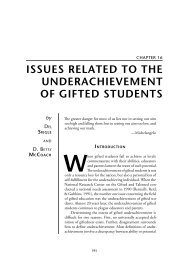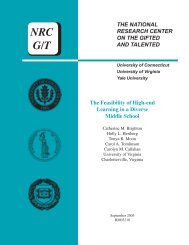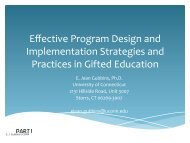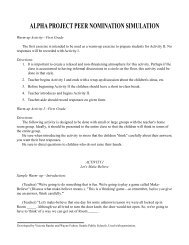Giftedness and High School Dropouts - Neag Center for Gifted ...
Giftedness and High School Dropouts - Neag Center for Gifted ...
Giftedness and High School Dropouts - Neag Center for Gifted ...
Create successful ePaper yourself
Turn your PDF publications into a flip-book with our unique Google optimized e-Paper software.
41<br />
CHAPTER 5: Conclusions <strong>and</strong> Suggestions <strong>for</strong> Future Research<br />
Conclusions<br />
Previous research studies have reported estimates of gifted dropouts. However,<br />
the ranges are widely varied depending on how giftedness <strong>and</strong> dropout were defined. In<br />
Study 2, approximately 28% of students were identified as gifted using a broad<br />
definition. Among 3,520 gifted students in the sample, about 5% dropped out of school.<br />
This percentage was similar to the percentage of dropouts (5.2%) from the non-gifted<br />
population. Because this number varies with the definition of gifted or dropout, it is not<br />
very meaningful to focus on the specific number of gifted students who dropped out of<br />
school. The focus should be on how we can identify potential gifted dropouts <strong>and</strong> how<br />
we can help them remain in school. The purpose of the present study was not to<br />
determine the number of gifted students who dropped out of school but to gain more<br />
comprehensive in<strong>for</strong>mation about gifted students who dropped out of school. More<br />
specifically, the focus was to obtain general characteristics of gifted students who<br />
dropped out of school <strong>and</strong> to explore personal <strong>and</strong> educational factors related to their<br />
dropout behavior.<br />
Identifying Potential <strong>Gifted</strong> <strong>Dropouts</strong><br />
The first step of effective dropout prevention is to identify students who are likely<br />
to drop out (Lunenburg, 2000). Underst<strong>and</strong>ing the characteristics of gifted students who<br />
drop out of school enables educators to identify potential gifted dropouts. Several<br />
characteristics of gifted students who dropped out of school were found in this study:<br />
• gifted students from low SES families<br />
• racial minority students, especially Hispanic <strong>and</strong> Native Americans<br />
• gifted students whose parents have low levels of education<br />
• students who participated less in extracurricular activities<br />
• gifted students who have low educational aspirations<br />
• gifted students who have a child or are expecting a child.<br />
First, study results confirmed that many gifted students who dropped out of<br />
school were from low SES families <strong>and</strong> ethnic minority groups, had parents with low<br />
levels of education, <strong>and</strong> participated less in extracurricular activities. The present study<br />
findings indicated that Hispanic <strong>and</strong> Native American gifted students are more likely to<br />
drop out of school, while White gifted students were less likely to drop out than other<br />
ethnic groups. In addition, the study results clearly revealed that SES <strong>and</strong> parents'<br />
educational level were significantly related to gifted students' dropping out of high<br />
school. Almost half the gifted students who dropped out of school (48.2%) were in the<br />
lowest quartile SES level, <strong>and</strong> only 3.6% of them were in the highest quartile SES level.<br />
This number was the reverse <strong>for</strong> gifted students who completed school. Also, a high<br />
percentage of parents whose gifted child dropped out of school did not finish high school<br />
or graduated from high school only. SES <strong>and</strong> parents' educational level may relate to




